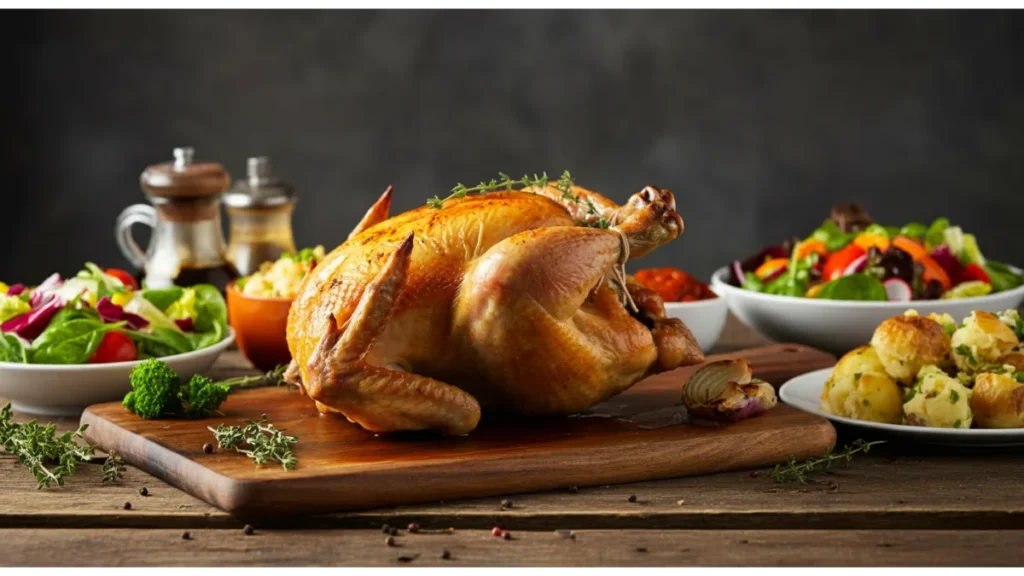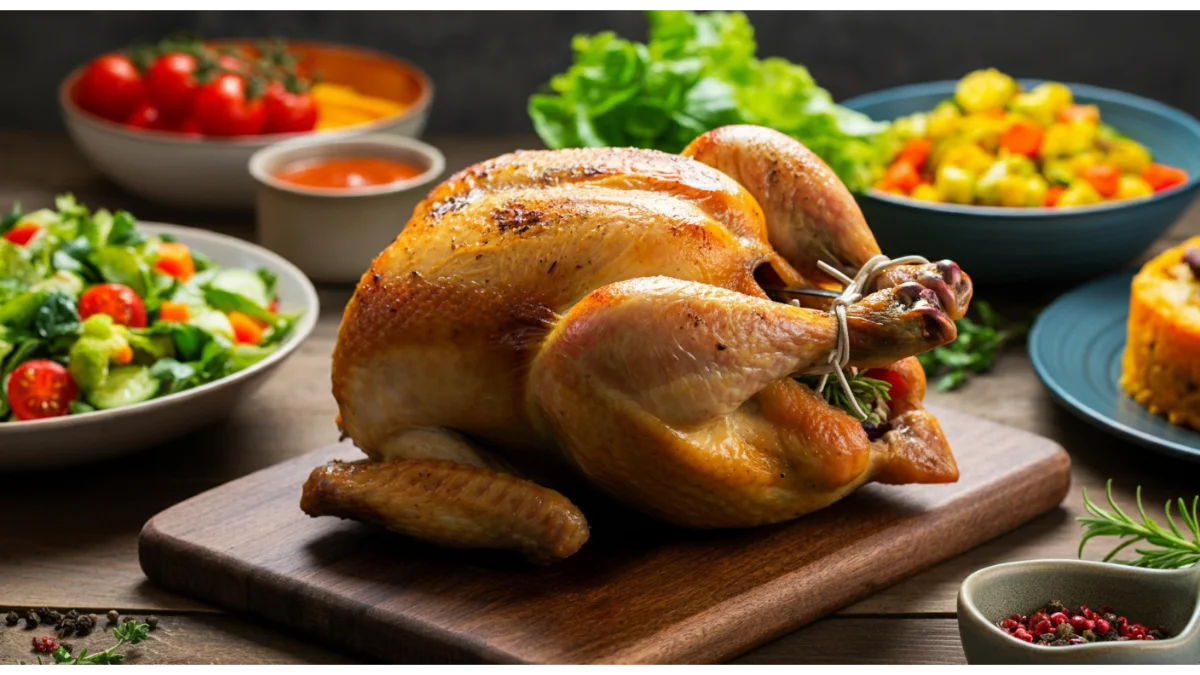Is Rotisserie Chicken Healthy? Unveiling the Truth About This Popular Dish
In today’s fast-paced world, convenience often reigns supreme when it comes to meal choices. One dish that has captured the hearts—and stomachs—of many is rotisserie chicken. It’s readily available in grocery stores and restaurants, offering a delicious and seemingly healthy option for busy individuals and families. But is rotisserie chicken truly healthy? In this article, we will delve deep into the nutritional aspects, benefits, and potential drawbacks of rotisserie chicken, providing you with all the information you need to make an informed decision about this popular dish.
Key Aspects of Rotisserie Chicken

Rotisserie chicken, often seasoned and slow-cooked on a rotating spit, has become a staple in many households. Here are some key aspects to consider:
- Nutritional Profile: Rotisserie chicken is typically high in protein and low in carbohydrates, making it an attractive option for those following low-carb or high-protein diets. A standard serving (about 3.5 ounces) contains approximately 25 grams of protein and only 1 gram of carbohydrates. This makes it a great source of energy without the added carbs.
- Convenience: One of the biggest selling points of rotisserie chicken is its convenience. It’s fully cooked and ready to eat, making it an ideal choice for busy weeknights or last-minute meals. You can grab one from the grocery store, and within minutes, you have a delicious meal on the table.
- Flavor and Versatility: The seasoning used on rotisserie chickens can vary widely, from classic herbs to spicy blends, allowing for a range of flavors that can cater to different palates. Additionally, rotisserie chicken can be used in various dishes, from salads and sandwiches to soups and casseroles. This versatility makes it a valuable ingredient in meal planning.
- Cost-Effectiveness: Compared to cooking a whole chicken at home, purchasing a rotisserie chicken can be more economical, especially when considering the time saved on preparation and cooking. Many families find that buying a rotisserie chicken is cheaper than ordering takeout, making it a practical choice for budget-conscious consumers.
- Health Considerations: While rotisserie chicken can be a healthy option, it’s essential to consider factors such as sodium content, additives, and the quality of the chicken itself. Many store-bought rotisserie chickens are seasoned with salt and preservatives, which can add to their overall calorie and sodium content. It’s crucial to read labels and choose options that align with your dietary preferences.
Ingredients List

When considering rotisserie chicken, the primary ingredient is, of course, the chicken itself. However, the seasoning and preparation methods can vary. Here’s a simple breakdown of common ingredients:
- Whole Chicken: Typically a young, tender chicken (broiler).
- Seasonings: Common seasonings include salt, pepper, garlic powder, onion powder, paprika, and various herbs (rosemary, thyme, etc.). Each of these adds flavor and can enhance the overall taste of the dish.
- Oil or Butter: Used to enhance flavor and moisture. Olive oil is a popular choice for its health benefits.
- Preservatives: Some commercially prepared rotisserie chickens may contain preservatives for extended shelf life. It’s advisable to look for brands that use natural ingredients.
Step-by-Step Instructions for Homemade Rotisserie Chicken
If you’re considering making your own rotisserie-style chicken at home, here’s a beginner-friendly guide:
Ingredients
- 1 whole chicken (3-4 pounds)
- 2 tablespoons olive oil or melted butter
- 1 tablespoon salt
- 1 teaspoon black pepper
- 1 tablespoon garlic powder
- 1 tablespoon onion powder
- 1 teaspoon paprika
- 1 teaspoon dried thyme or rosemary
Instructions
- Preheat Your Oven: Preheat your oven to 375°F (190°C). This guarantees that your chicken is cooked uniformly and completely.
- Prepare the Chicken: Take out any giblets from the cavity of the chicken and use paper towels to dry it off. Ensuring the chicken is dry contributes to a crispier skin.
- Season the Chicken: In a small bowl, mix the salt, pepper, garlic powder, onion powder, paprika, and herbs. Rub the olive oil or melted butter all over the chicken, ensuring it’s evenly coated. Then, sprinkle the seasoning mixture generously over the chicken, both inside and out. This step is crucial for flavor.
- Roast the Chicken: Set the chicken breast-side up in a roasting pan. Cook it in the preheated oven for approximately 1 hour and 15 minutes, or until its internal temperature hits 165°F (75°C). Halfway through the cooking time, baste the chicken with its own juices to enhance moisture. This technique helps maintain the juiciness and flavor of the meat.
- Rest and Serve: Once cooked, remove the chicken from the oven and let it rest for 10-15 minutes before carving. This gives the juices a chance to redistribute, resulting in a chicken that is both moist and flavorful. Carve and serve with your favorite sides.
Nutritional Value
Here’s a table outlining the nutritional value of a standard serving of rotisserie chicken (3.5 ounces or 100 grams):
| Nutrient | Amount per Serving | % Daily Value* |
|---|---|---|
| Calories | 170 | 8% |
| Protein | 25g | 50% |
| Total Fat | 7g | 11% |
| Saturated Fat | 2g | 10% |
| Cholesterol | 85mg | 28% |
| Sodium | 400mg | 17% |
| Total Carbohydrates | 1g | 0% |
| Fiber | 0g | 0% |
| Sugars | 0g | 0% |
*Based on a 2,000-calorie diet.
Benefits of Rotisserie Chicken

Rotisserie chicken offers several benefits that can enhance your diet and lifestyle:
- High Protein Content: The high protein content makes rotisserie chicken an excellent option for muscle repair and growth, making it a favorite among fitness enthusiasts. Protein is essential for building and repairing tissues, and it plays a significant role in overall health.
- Convenient Meal Prep: With a rotisserie chicken, you can create multiple meals throughout the week. Use it in salads, sandwiches, wraps, or as a protein source in grain bowls. This versatility allows for easy meal prep and reduces cooking time during the week.
- Time-Saving: Cooking a whole chicken from scratch can take hours. Rotisserie chicken saves you time while still providing a nutritious meal option. This enables you to minimize your time in the kitchen and maximize your enjoyment of the meal with family or friends.
- Flavor Variety: The diverse seasoning options allow you to enjoy different flavors without the hassle of preparing multiple dishes. Whether you prefer a classic herb blend or something spicier, there’s a rotisserie chicken flavor for everyone.
- Affordable: Compared to dining out or purchasing pre-packaged meals, rotisserie chicken is often more affordable, providing a cost-effective solution for healthy eating. This can be especially beneficial for families looking to save money while still eating well.
Real-Life Example
Picture yourself arriving home after a tiring day at the office. You’re exhausted and don’t feel like cooking. Instead of ordering takeout, you grab a rotisserie chicken from the grocery store. In just minutes, you can whip up a quick salad or pair it with some steamed vegetables. Not only do you save time, but you also provide your body with the nourishment it needs. This scenario illustrates how rotisserie chicken can be a lifesaver for busy individuals.
Overcoming Challenges
While rotisserie chicken is a convenient meal option, there can be challenges associated with its consumption. Here are some practical tips to address common issues:
- High Sodium Content: A significant number of rotisserie chickens are heavily seasoned with salt, potentially resulting in excessive sodium consumption. To mitigate this, look for low-sodium options or consider rinsing the chicken under cold water before eating to reduce sodium levels. Additionally, you can create your own seasoning blend at home to control the salt content.
- Additives and Preservatives: Some store-bought rotisserie chickens contain preservatives. Check labels and opt for brands that use natural ingredients whenever possible. Choosing organic or free-range chickens can also help minimize exposure to unwanted additives.
- Portion Control: It’s easy to overeat when you have a delicious chicken in front of you. Be mindful of portion sizes, especially if you’re watching your calorie intake. Consider using a food scale or measuring cups to serve appropriate portions.
- Leftover Storage: If you have leftovers, store them properly to avoid spoilage. Keep any leftover chicken in a sealed container and place it in the refrigerator. Consume within 3-4 days. For longer storage, consider freezing the leftovers for future meals.
- Balancing Meals: To create a balanced meal, pair rotisserie chicken with a variety of colorful vegetables and whole grains. This not only enhances the nutritional value of your meal but also makes it more visually appealing.
Future Trends
As consumer preferences evolve, several trends are emerging regarding rotisserie chicken:
- Health-Conscious Options: There’s a growing demand for healthier rotisserie chicken options, including organic and free-range chickens. These options cater to health-conscious consumers looking for quality over quantity. Grocery stores are increasingly stocking these varieties to meet consumer demand.
- Flavor Innovations: Expect to see more unique flavor profiles, such as global spices and marinades, as brands seek to differentiate themselves in a competitive market. This trend allows consumers to explore new tastes and culinary experiences.
- Sustainability: With an increasing focus on sustainability, more consumers are seeking rotisserie chicken that is ethically sourced and environmentally friendly. Brands that prioritize sustainable practices are likely to gain favor among eco-conscious shoppers.
- Meal Kits and Delivery Services: The rise of meal kits and delivery services may incorporate rotisserie chicken as a key ingredient, making it even easier for consumers to enjoy healthy meals at home. This convenience aligns with the hectic schedules of many contemporary consumers.
- Plant-Based Alternatives: As plant-based diets gain popularity, we may see the emergence of rotisserie-style plant-based products that mimic the taste and texture of chicken. This could cater to those looking to reduce their meat consumption while still enjoying the flavors they love.
Tips and Tricks Section
To enhance your experience with rotisserie chicken, consider these helpful tips:
- Pairing Ideas: Serve rotisserie chicken with a variety of sides like roasted vegetables, quinoa, or a fresh salad to create a balanced meal. Try out various combinations to discover your preferred pairings.
- Flavor Enhancements: Add a squeeze of lemon or a drizzle of balsamic glaze to elevate the flavor of your rotisserie chicken. Fresh herbs can also brighten up the dish and add a burst of flavor.
- Use the Bones: Don’t discard the bones! Use them to make a rich chicken broth, which can serve as a base for soups and stews. Simply simmer the bones with water, vegetables, and herbs for a flavorful broth.
- Meal Prep: Shred leftover chicken and store it in the fridge for quick access during the week. It can be added to salads, tacos, or pasta dishes, making meal prep a breeze.
- Experiment with Recipes: Get creative with your rotisserie chicken by trying new recipes. Use it in stir-fries, casseroles, or even as a topping for pizza. The possibilities are endless!
Variations and Adaptations
Rotisserie chicken can easily fit into various dietary preferences. Here are some diet-friendly variations:
- Gluten-Free: Rotisserie chicken is naturally gluten-free. Just be cautious of any sauces or marinades that may contain gluten. Always check labels to ensure your meal remains gluten-free.
- Low-Carb/Keto: Pair rotisserie chicken with low-carb vegetables like zucchini or cauliflower rice for a satisfying keto meal. This combination keeps your carb intake low while providing essential nutrients.
- Paleo: Enjoy rotisserie chicken with a side of roasted sweet potatoes and steamed broccoli for a wholesome paleo meal. This meal is packed with nutrients and aligns with paleo principles.
- Vegetarian Option: For those who prefer plant-based diets, consider using marinated tofu or tempeh as a protein substitute in similar recipes. These alternatives can provide a fulfilling and healthy choice.
- Family-Friendly Meals: Create kid-friendly meals by incorporating rotisserie chicken into dishes like chicken quesadillas, chicken nuggets, or pasta salads. These adaptations make it easier to include healthy options in family meals.
FAQs Section
1. Can I freeze leftover rotisserie chicken?
Yes, you can freeze leftover rotisserie chicken. Ensure you keep it in a sealed container or freezer bag. It can remain good for up to 4 months when frozen. Thaw it in the refrigerator before reheating.
2. How do I reheat rotisserie chicken?
To reheat, place the chicken in an oven preheated to 350°F (175°C) for about 20-25 minutes, or until heated through. You can also use a microwave, but this may result in a less crispy texture.
3. What are some good side dishes for rotisserie chicken?
Some great side dishes include roasted vegetables, mashed potatoes, coleslaw, or a fresh garden salad. These sides complement the chicken and add variety to your meal.
4. Is rotisserie chicken safe to eat after the expiration date?
It’s best to consume rotisserie chicken before the expiration date. If stored properly in the fridge, it can be safe to eat for 3-4 days after cooking. Always check for signs of spoilage before consuming.
5. Can I use rotisserie chicken in recipes?
Absolutely! Rotisserie chicken is versatile and can be used in soups, salads, tacos, and pasta dishes. It’s a great way to add protein to your meals without additional cooking time.
Conclusion
In conclusion, rotisserie chicken can be a healthy and convenient meal option when chosen wisely. With its high protein content, affordability, and versatility, it fits well into various diets and lifestyles. However, it’s crucial to be mindful of sodium levels and ingredient quality. By understanding the benefits and potential challenges, you can make informed choices about incorporating rotisserie chicken into your meals.
If you found this article helpful, please share your thoughts in the comments below, and don’t forget to subscribe for more insights on healthy eating!

Rotisserie Chicken
Ingredients
For the Chicken
- 1 whole chicken (3-4 pounds) whole chicken Typically a young, tender chicken (broiler)
- 2 tablespoons olive oil or melted butter Used to enhance flavor and moisture
- 1 tablespoon salt
- 1 teaspoon black pepper
- 1 tablespoon garlic powder
- 1 tablespoon onion powder
- 1 teaspoon paprika
- 1 teaspoon dried thyme or rosemary
Instructions
Preparation
- Preheat your oven to 375°F (190°C).
- Take out any giblets from the cavity of the chicken and use paper towels to dry it off.
- In a small bowl, mix the salt, pepper, garlic powder, onion powder, paprika, and herbs.
- Rub the olive oil or melted butter all over the chicken, then sprinkle the seasoning mixture generously over the chicken, both inside and out.
Cooking
- Set the chicken breast-side up in a roasting pan.
- Cook it in the preheated oven for approximately 1 hour and 15 minutes, or until its internal temperature hits 165°F (75°C).
- Halfway through the cooking time, baste the chicken with its own juices.
Serving
- Once cooked, remove the chicken from the oven and let it rest for 10-15 minutes before carving.
- Carve and serve with your favorite sides.

